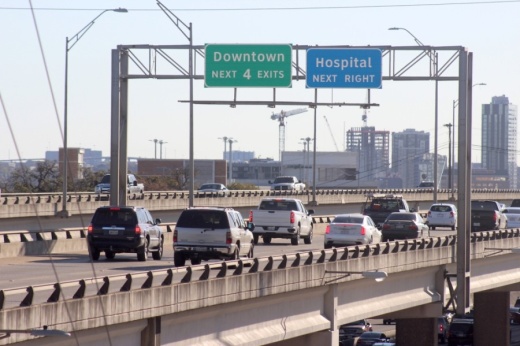The research institution released its 2020 list Dec. 1. Five of the top seven most congested roads were in Harris County. Dallas roads held down the fourth, eighth and ninth spots. But I-35 through downtown Austin came in at the very top of the list at No. 1.
The 8-mile stretch between Hwy. 290 and SH 71 has long been near the top of the ignominious list. It was second last year and third in 2018, but this is the first time it has risen to first—and been deemed worse than Houston's Loop 610—since 2015.
The Texas Department of Transportation is in the early stages of a project to address these congestion issues—one that will cost $4.9 billion and is set to add two managed lanes for public transit, emergency vehicles and carpools. Construction on that massive project is not set to begin until 2025, but TxDOT officials said now is the best time for the public to give feedback.
A virtual public scoping meeting, which shows three potential designs for the project and allows residents to submit comments, is open through Dec. 31. TxDOT officials said another meeting is set to be held early next year.
Alternatives on the table
The open house presents three proposals for the I-35 project, although at this point the designs are just conceptual to help residents visualize how TxDOT could go forward. Diann Hodges, public information officer for TxDOT's Austin district, said they are not the only options on the table.
"What the final design looks like, we don't know. That's still in the works. We want to hear from the public," Hodges said.
All three designs would take down the upper decks on I-35 running from Airport Boulevard to Martin Luther King Jr. Boulevard.
One alternative would tunnel the managed lanes underneath the main lanes through much of the project area.
A second design would keep the main lanes and managed lanes at the same level but set them all lower than the frontage road. Finally, a third proposal would do the same but add raised overpasses for the managed lanes at Airport Boulevard in North Central Austin and Woodland Avenue near the south end of the project.
The phase TxDOT is in now—gathering public feedback along with environmental review—will continue through 2021, and Hodges said by summer 2022, residents can expect TxDOT to solidify its plan and select a design.
"We are open to considering other things [in addition to the proposed designs]. This has been a long process. These ideas are coming out of feedback we've received previously, and we'll take what we receive now to modify those concepts," Hodges said.
As the most congested roadway in the state, Hodges said it would be "irresponsible" for TxDOT to not address the issue by adding capacity for a growing area.
"We have seen an explosive amount of growth in Texas and Austin that isn't slowing down. We have looked at that, looked at the traffic, projected the traffic numbers down the road, and we're trying to address that," she said
A new approach
While TxDOT officials said the department is open to any and all feedback, some community members were frustrated by the initial release of designs because they said the state agency is coming at the project with the wrong approach.
Brendan Wittstruck, who is part of a group called the North Central I-35 Neighborhood Coalition, or NCINC2, said he was disappointed to see the initial designs show I-35 growing to as many as 20 lanes wide in some sections of the highway with the addition of managed lanes to the main lanes and frontage roads.
"When we know vehicle emissions are a major driver of climate change, why are we talking about adding vehicles? When we know expanding capacity will induce demand and not solve a problem, why are we looking at that as a solution?" Wittstruck said.
A group called Rethink 35 is calling for replacing I-35 with a boulevard rather than expanding it to include additional lanes. While some may think removing traffic lanes will lead to worsening congestion, the group argues in fact, replacing the highway with a boulevard will lessen congestion because it will divert large trucks to other routes, reconnect the street grid across I-35 and lead people to seek alternatives rather than driving.
Rethink 35 pointed to examples in other cities, most recently Rochester, New York's removal of part of its inner loop in 2016, where highway removal has led to improved, not worsened, traffic flow.
Groups such as Wittstruck's NCINC and Reconnect Austin, which has long advocated for a proposal to remove the upper decks, bury the highway's main lanes and stitch together the street grid across the highway, are hoping TxDOT will consider quality of life, environmental impacts, and socioeconomic and race inequities among its priorities as the agency analyzes the purpose and need of the project. They are calling for TxDOT to think about more than how fast vehicles move when considering how to fix I-35.
"With TxDOT, we're always asking the wrong question. To us, the highway is not the connection from Mexico to Minneapolis; it's a boundary that's cutting apart our ability to move around in our home," Wittstruck said.





